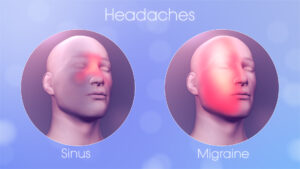Do you suffer from frequent headaches? Are they sinus headaches or migraines? It can be hard to tell the difference between these two types of headaches, but it’s important to understand their differences in order to get relief. Sinus headaches and migraine are both painful conditions that affect millions of people around the world, but when it comes down to it, some distinct characteristics set them apart. In this article, we’ll explore the key differences between a sinus headache vs migraine so you can better identify which type of pain affects you and how to best treat it.
Sinus Headache
Sinus headaches are caused by inflammation or infection in the sinus cavities. The most common cause is a viral or bacterial infection of the upper respiratory system, such as the common cold or flu. Allergies can also be a trigger for sinus headaches, as can irritants like smoke or perfume. Other conditions that can lead to sinus headaches include a deviated septum, a blocked nasal passage, or an underlying medical condition.
Typical symptoms of a sinus headache include:
- Pressure around the eyes, nose and cheeks
- Nasal congestion
- Tenderness in the face
- Thick yellow-green discharge from your nose
- Loss of smell or taste
- Fever
With that said, “sinus headache” is not actually a recognized term in the International Classification of Headache Disorders (ICHD3), despite how much this term is thrown around as a common belief. There are two sinus associated headaches that are recognized in these diagnostic criteria. They include “headache attributed to acute rhinosinusitis” and “headache attributed to chronic or recurring rhinosinusitis”.
In other words, if there is an active sinus infection acutely (current), or recurrent sinus infections, these are really considered the only true causes of real “sinus headache”. Outside of this, sinuses are not typically felt to be causes of headaches, no matter how many allergies you have.
In fact, most sinus symptoms occurring with headache are actually migraine, especially if there is any throbbiness to the pain (or nausea, or sensitivity to light and sound). Migraine commonly causes referred pain into the face, especially over the sinus areas.
Migraine also activates the sinus pathways, thus the sinus symptoms that occur with migraine such as facial pressure, drainage, congestion, etc. The connection between all of these factors is discussed in greater detail here, but is all traced back to the trigeminal nerves.
One common characteristic that facial pain, headaches, and migraines all share is that they cause pain and discomfort in your head and face. More importantly, these symptoms all originate in the trigeminal nerves. The trigeminal nerves innervate the entire face, the sinus cavities, the teeth, the TMJ areas, the inside of the skull and brain, and the front half of the head.
Depending on the nature of the disorder, the pain may manifest in differing ways within any of these areas mentioned, especially headache and facial pain. Often one type of pain (such as headache) may refer pain into other areas (such as face) within this same network of nerves.
I tell patients if this trigeminal nerve is activated in one area, it will often spread and activate other areas of pain as well. For example, migraine headaches commonly refer pain into the face, the sinus areas, the teeth, the TMJ areas, and the neck. The pain can range in terms of severity.
How often is sinus headache misdiagnosed as migraine?
A study of almost 3,000 patients with self-diagnosed or doctor diagnosed sinus headaches showed that 88% of the patients actually had migraine according to ICHD3 criteria, not sinus headaches! The most common sinus symptoms reported in that study were sinus pressure (84%), sinus pain (82%), and nasal congestion (63%).
Another study called the American Migraine Study II showed similar results. This was a study involving 30,000 patients. About 50% of patients who were eventually diagnosed with migraine had been previously misdiagnosed, and the most common prior misdiagnosis was sinus headache.
Yet another study that looked at 100 patients with self-diagnosed sinus headaches. After a detailed history and exam, patients were given headache diagnoses based on the ICHD3 criteria. Of the 100 patients with self-diagnosed headache, 86% were diagnosed with a migraine related headache disorder, rather than a sinus related headache.
Common Treatment Options
Common treatments for sinus headaches involve relieving the underlying cause. If a viral or bacterial infection is present, antibiotics may be prescribed to fight it. Allergy medications can help if allergies are causing sinus headaches. Decongestants and nasal sprays can be used to reduce pressure in the sinuses and provide relief from congestion.
OTC Treatment Options
There are a number of over-the-counter medications that can be taken to help relieve sinus headache symptoms. Acetaminophen (Tylenol) effectively relieves pain and pressure associated with sinus headaches.
Ibuprofen (Advil, Motrin) or Naproxen (Aleve) can also provide relief from inflammation and congestion. Decongestants like pseudoephedrine (Sudafed) can reduce swelling and open up the nasal passages.
Migraine
A migraine is a type of severe headache distinguished by intense, throbbing or pulsating pain that is commonly felt on one side of the head. It is believed to be caused by abnormal activity in the nerves and blood vessels in the brain and can last anywhere from 4 to 72 hours. Migraine symptoms can include nausea, vomiting, sensitivity to light and sound, and changes in vision.
Causes of Migraines
The exact cause of migraines is unknown, but they are believed to be caused by a combination of environmental, genetic and biochemical factors. Triggers for migraines can include stress, fatigue, certain foods or drinks, changes in hormones (such as those seen during menstruation), medication overuse and sensory stimuli such as light or sound.
Common Treatment Options
Treatment for migraines depends on the severity of the symptoms. The options may include medications such as triptans, gepants, ditans, or NSAIDs to reduce pain of the attack acutely, and preventive treatments to further lessen the frequency and severity of migraine attacks.
If you see an ENT (ear, nose and throat) doctor that tells you that he can “cure your migraines” by doing sinus surgery, you should consider running from there as quick as possible. I have seen countless patients over many years with migraine who have undergone sinus surgeries (sometimes multiple) in order to treat their migraine. I have yet to see it actually improve their migraines though.
Lifestyle changes such as stress management, relaxation techniques, regular exercise and avoiding known triggers can also be effective. OTC drugs like ibuprofen or acetaminophen can also be taken to relieve the pain.
OTC Treatment Options
Medications like ibuprofen (Advil, Motrin) and acetaminophen (Tylenol) can help reduce the severity of migraine symptoms. Other OTC drugs such as aspirin, naproxen sodium (Aleve), and caffeine can also be taken to relieve pain. It is important to talk to your doctor before taking any of these medications, as they can have side effects or interact with other medications you may be taking.
Sinus Headache vs Migraine: What’s the Difference?
Understanding the differences between sinus headaches and migraines is important to effectively treat them. Although they share some of the same symptoms, such as pressure around the eyes and nose, tenderness in the face, and sensitivity to light, there are distinct differences between the two conditions.
Sinus headaches are caused by inflammation (typically from infection) of the sinuses, whereas migraines are believed to be caused by abnormal activity in the nerves and blood vessels in the brain.
The treatment for each condition will also differ; while medications such as antibiotics may be prescribed to treat a sinus headache, migraine treatments typically involve medications such as triptans or NSAIDs, lifestyle changes and avoiding known triggers. Additionally, OTC medications like ibuprofen or acetaminophen can be taken to relieve the pain associated with migraines or a sinus headache.
How to Identify a Sinus Headache?
A sinus headache is typically felt in the areas of the face and head around the sinuses, such as across the forehead, around the eyes, or behind the cheeks. The pain associated with a sinus headache can range from mild to severe but is generally described as a dull ache or pressure-like feeling.
Additionally, some people may experience an increase in sinus congestion or pressure, a feeling of being “stopped up”, or a decreased sense of smell or taste. In contrast, patients with migraine are often over sensitive to smells.
Sinus headaches are not the only type of headache that can cause similar symptoms. Cluster headaches, tension headaches, and even migraines can all present with pain around the eyes, nose, or forehead. However, the underlying causes of these various types of headaches can vary greatly.
In addition to the pain around the eyes, nose and forehead, sinus headaches can also cause a range of other symptoms in those suffering from this condition. Nasal congestion is one of the most common symptoms associated with sinus headaches and a feeling of facial pressure.
Other symptoms may include tenderness or swelling of the face, a decrease in the sense of smell or taste, and sensitivity to light. If you think you’re experiencing a sinus headache, it is important to consult your doctor for an accurate diagnosis and appropriate treatment.
How to Identify a Migraine?
Migraines typically begin as a dull, throbbing pain on one side of the head that can escalate to become an intense pounding sensation. It can also involve both sides of the head. The pain is usually accompanied by sensitivity to light, sound and smell, nausea, and vomiting.
It can also be accompanied by visual disturbances such as auras or flashes of light. Migraine pain usually lasts for a few hours to several days and can be so severe that it interferes with your daily activities.
Conclusion
The key differences between sinus headache vs migraine is in the cause, symptoms, and treatment. Sinus headaches are caused by inflammation of the sinuses typically from an infection, whereas migraines are believed to be caused by abnormal electrical activity in the nerves and blood vessels in the brain.
The treatment for each condition will differ; while medications such as antibiotics may be prescribed to treat a sinus headache, migraine treatments typically involve medications such as triptans or NSAIDs, lifestyle changes and avoiding known triggers. If you are experiencing possible symptoms of either condition, see your doctor for an accurate diagnosis and appropriate treatment.
IF YOU HAVE HEADACHE, MIGRAINE, OR FACIAL PAIN AND ARE LOOKING FOR ANSWERS ON ANYTHING RELATED TO IT, A HEADACHE SPECIALIST IS HERE TO HELP, FOR FREE!
FIRST, LET’S DECIDE WHERE TO START:
IF YOU HAVE AN EXISTING HEADACHE, MIGRAINE, OR FACIAL PAIN DIAGNOSIS AND ARE LOOKING FOR THE LATEST INFORMATION, HOT TOPICS, AND TREATMENT TIPS, VISIT OUR FREE BLOG OF HOT TOPICS AND HEADACHE TIPS HERE. THIS IS WHERE I WRITE AND CONDENSE A BROAD VARIETY OF COMMON AND COMPLEX MIGRAINE AND HEADACHE RELATED TOPICS INTO THE IMPORTANT FACTS AND HIGHLIGHTS YOU NEED TO KNOW, ALONG WITH PROVIDING FIRST HAND CLINICAL EXPERIENCE FROM THE PERSPECTIVE OF A HEADACHE SPECIALIST.
IF YOU DON’T HAVE AN EXISTING HEADACHE, MIGRAINE, OR FACIAL PAIN DIAGNOSIS AND ARE LOOKING FOR POSSIBLE TYPES OF HEADACHES OR FACIAL PAINS BASED ON YOUR SYMPTOMS, USE THE FREE HEADACHE AND FACIAL PAIN SYMPTOM CHECKER TOOL DEVELOPED BY A HEADACHE SPECIALIST NEUROLOGIST HERE!
IF YOU HAVE AN EXISTING HEADACHE, MIGRAINE, OR FACIAL PAIN DIAGNOSIS AND ARE LOOKING FOR FURTHER EDUCATION AND SELF-RESEARCH ON YOUR DIAGNOSIS, VISIT OUR FREE EDUCATION CENTER HERE.







